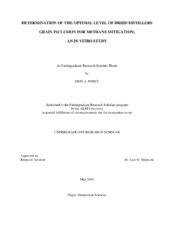| dc.creator | Posey, Erin | |
| dc.date.accessioned | 2016-09-05T14:38:29Z | |
| dc.date.available | 2016-09-05T14:38:29Z | |
| dc.date.created | 2016-05 | |
| dc.date.issued | 2015-11-10 | |
| dc.date.submitted | May 2016 | |
| dc.identifier.uri | https://hdl.handle.net/1969.1/157698 | |
| dc.description.abstract | The negative effects of high level of methane emissions from cattle operations are of particular concern to producers. Current management practices call for a variety of feed additives to be used to help mitigate methane production and enhance overall animal efficiency. However growing consumer concern and increasing regulations have led to the requirement of new management practices. Dried Distillers Grain (DDG) in both whole and defatted forms has shown promising effects on methane mitigation, however an optimal level of inclusion has yet to be found for either form of the additive. By using an in vitro gas production (IVGP) technique to model the rumen environment, different percentages and forms of DDG inclusion can be compared and an optimal level and form can be determined by comparing the gas chromatography (GC) results of methane concentration following the incubation of each diet containing a different level and form of DDG inclusion. | en |
| dc.format.mimetype | application/pdf | |
| dc.subject | dried distillers grain, methan mitigation, hydrogen sink | en |
| dc.title | Determining the Optimal Level of Dried Distillers Grain Inclusion for Methane Mitigation; an In Vitro Study | en |
| dc.type | Thesis | en |
| thesis.degree.discipline | Biomedical Science | en |
| thesis.degree.grantor | Undergraduate Research Scholars Program | en |
| dc.contributor.committeeMember | Tedeschi, Luis O | |
| dc.type.material | text | en |
| dc.date.updated | 2016-09-05T14:38:29Z | |


